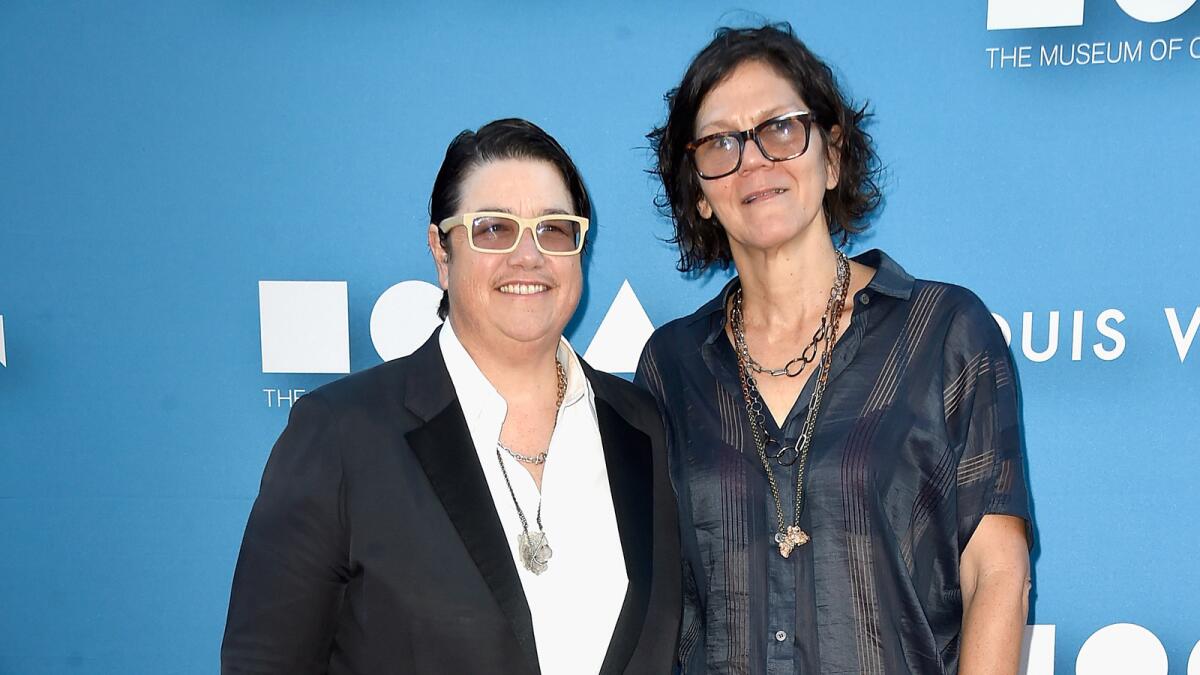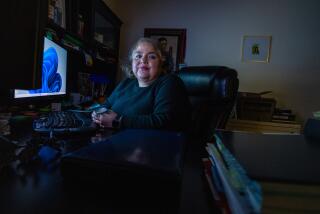Supreme Court’s gay marriage decision sparks art world jubilation

Catherine Opie, left, and Julie Burleigh had to defer their wedding for years because of Prop. 8.
This post has been updated. Please see below.
Catherine Opie knows firsthand about the one step forward, two steps back pattern of legal rulings on same sex marriage in the U.S.
The noted Los Angeles artist and UCLA professor was poised to marry her partner, garden designer Julie Burleigh, in 2008, when same-sex couples were briefly allowed to marry after a favorable civil rights ruling by the state Supreme Court. Then California voters passed Prop. 8, which stopped the weddings, including Opie and Burleigh’s.
Opie was jubilant over Friday’s U.S. Supreme Court decision establishing the right to marry for gay couples.
As a photographer who has dealt often with questions of identity and sexuality, Opie channeled the legal rejection of Prop. 8 and her marriage plans into art. That particular heartbreak now belongs to the past.
“It’s about humanity, about equality, and it’s pretty huge,” Opie said. “I think of all my younger students and the rights they’re going to have that I never had as a possibility as a young gay person.”
Opie collaborated with filmmaker Lisa Udelson on a 2011 documentary, “Same Difference,” showing how the inability of their parents to marry affected children of same-sex couples.
Her photographic portrait of Edith Windsor, whose lawsuit figured in a key 2013 Supreme Court decision that was a prelude to Friday’s decision on marital rights, is hanging at the Wexner Center of the Arts in Columbus, Ohio, part of its current exhibition, “Catherine Opie: Portraits and Landscapes.”
That ruling gave Opie and Burleigh the confidence to marry last year.
Discrimination against gays and lesbians was an important driver of Opie’s work in the early 1990s, when she was emerging on the art scene.
“I was trying to be very brave, creating ideas of representation within my own community,” she said. “Unbelievable art was made through this time period.”
But she doesn’t see normalization of gays’ legal status as a damper on art fueled by a sense of injustice.
“There’s still homophobia out there, just as there is racism. There will still be art made in connection with those struggles,” Opie said.
Veteran art museum director Maxwell Anderson has spent nearly a decade working in red states – as director of the Indianapolis Museum of Art and, since 2012, the Dallas Art Museum.
“It’s very sweet justice to see the Supreme Court do this,” he said. “Dallas is a progressive city with a solidly progressive mayor and city council, but in other areas of Texas that may not be the case.”
Anderson said one of his first actions in Dallas was to secure benefits for same-sex domestic partners of museum employees to put them on an equal footing with those who were legally wed.
“Our human resources director said, ‘We haven’t done that before,’ and I said, ‘We’re doing it now.’ I’m very pleased today about what’s happened in our country.”
Joel Wachs, the former Los Angeles City Council member who’s now head of the Andy Warhol Foundation for the Visual Arts in New York, thinks the decision may be especially helpful for artists and institutions in places that traditionally have resisted creative depictions of gay lives and the political and social struggles of gays.
“Those kinds of exhibitions don’t often happen in certain parts of the country,” said Wachs, who oversees a far-reaching, well-funded grant-making program for nonprofit visual art institutions and exhibitions across the United States.
“There is always a really strong artistic community even in the most conservative red states, but they’ve had a harder time sometimes dealing with the issues society has censored,” Wachs said. “Now they’re going to have an easier time. They won’t have to be so careful about what they show, what they propose and what they do. Society as a whole is going to perceive gay and lesbian and transgender people differently than before. There’s a legitimacy.”
Wachs agrees with Opie that the end of legally condoned homophobia need not mean less urgent inspiration for artists.
“The world’s problems won’t be solved by this one case.”
But Jonathan Katz, a University at Buffalo professor of art history who focuses on the intersection between art and gay culture, thinks gay and lesbian artists may now have to dig for different kinds of inspiration.
Katz was co-curator of “Hide/Seek,” a groundbreaking 2010 exhibition at the Smithsonian Institution’s National Portrait Gallery that showcased the work of gay and lesbian artists.
A storm broke out when pressure from conservative leaders in Congress and conservative Christian groups prompted Smithsonian Secretary G. Wayne Clough to remove an AIDS-themed video by David Wojnarowicz that used a crucifix in its imagery.
Given rapidly changing views of gays and lesbians, that wouldn’t happen today, said Katz, who’s also co-curator of “Art AIDS America,” an exhibition having what he called a “sneak preview” through Sept. 6 at two West Hollywood venues – the municipal library and ONE Archives Gallery and Museum.
The show, which will have its formal debut this fall at the Tacoma Art Museum in Washington, is a survey exhibition examining artists’ response to the AIDS crisis.
With Friday’s ruling, Katz said, “not only would the political pressure not be the same” as it was five years ago at the Smithsonian, “but there would no longer be the presumption that this kind of censorial behavior is supported by a majority of the federal government. I think it’s going to make a substantive difference. We’ll see many fewer instances of essentially beating up on queers.”
But he thinks the victory could also pose challenges for artists dealing with gay and lesbian themes.
When discrimination was the social and legal norm, he said, “the necessary strategies of hiding and concealment and coded references made for art of great complexity and great nuance. I fear we will become, in some respects, more banal, and it will have ramifications in the art we produce. I don’t think it will mean the end of good queer art; it just means sexuality will no longer be the motive force. Other things will have to stand in its place. We will have to find other ways to manifest a queer view of the world, a queer perception of things.”
Katz married under New York state’s law permitting same-sex marriage, but he said Friday’s ruling frees him and his husband to move anywhere in the country they might like.
“Places that did not recognize my civil rights would not have been on my list of places to live – until today,” he said.
For the record, June 28, 12:40 p.m.: An earlier version of this post used an incorrect name for the university where Jonathan Katz teaches. It is the University at Buffalo, not University of Buffalo.
Follow @boehmm of the LA Times for arts news and features
More to Read
The biggest entertainment stories
Get our big stories about Hollywood, film, television, music, arts, culture and more right in your inbox as soon as they publish.
You may occasionally receive promotional content from the Los Angeles Times.











